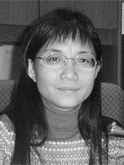Wenfang Sun

Wenfang Sun, Assistant Professor, Department of Chemistry, Biochemistry and Microbiology, and the only female faculty member in the department, stands tall and confident in her petite frame, sitting at her desk in her immaculate office in Dunbar Hall. Her energy bounces off the old oak paneling that lines her office. Coming from a small city in China with a population of 300,000, she grew up in a family of academicians in which education was highly regarded. Inspired by the French Chemist Marie Curie, Wenfang grew up knowing that she would have to fight many gender barriers. She would come to believe that girls can be better. In elementary school, Wenfang excelled at language, writing and mathematics. Her consistent standing at the top of her class, however, automatically moved her toward a career in science. That was the tradition and the culture. Students labeled “smart” went into science. Her choice was also fueled by her desire to break traditional societal expectations that girls not pursue science majors.

Wenfang entered college with an undergraduate major in analytical chemistry. After the first two years she developed a keen interest in organic chemistry. To pursue her new interest, she had to switch majors. “Such was the rigidity of the programs,” she recalled with amusement. Wenfang received her doctorate degree in organic chemistry from the Institute of Photographic Chemistry, Chinese Academy of Sciences, in 1995. Her doctoral work focused on the development of photosensitive porphyrin-like metal complexes that showed a wide variety of applications in nonlinear optics and medical diagnostics. She was employed by the same institute as a Research Assistant Professor (1995-1996) and then promoted to a Research Associate Professor (1996-1997). A postdoctoral research opportunity at the University of Birmingham in the Physics Department brought her to the United States in 1997. She was promoted to a Research Assistant Professor in 1999. In 2001, she joined NDSU as the first and the only female faculty member in the Chemistry Department.

What is most notable about Wenfang is how she speaks with emotion and intensity about her research. Her current research at NDSU is on photonic materials. She is interested in the synthesis and spectroscopic characterization of a variety of novel organic/organometallic compounds that have several promising applications: for eye protection (optical limiting); for medical diagnostics and/or treatment of benign or cancerous tumors (near-IR detection and/or photodynamic therapy); and as chemical sensors. In addition, her research includes design of new organometallic complexes for fabrication of solar cells. Her research is highly interdisciplinary, lying between an understanding of the photophysical and optical properties of optical materials and chemistry, and the synthetic techniques to make them. At NDSU, she is a principal investigator or co-principal investigator on several prestigious grants, most notably the NSF CAREER award, the NSF NIRT, grant and a grant from USDA. Her efforts to promote her Department’s infrastructure have led to the establishment of a new optical and spectroscopic laboratory which is equipped with state-of-art lasers and spectrometers. Reflecting over her time at NDSU, she recalls the year her son was born as the same year she worked late nights setting up her laboratory. Wenfang, now the mother of a two year old, continues to work tirelessly, but does not appear tired. On the contrary, she talks with animated passion about the third-order nonlinear optical properties of semiconductor and gold nanoparticles.
Individuals credit their success to many sources. For Wenfang, the road to a successful academic career is paved with a few simple things. In her own words, “These are devotion to work, love for research, believing in your self in every circumstance, and having confidence.” She also acknowledges the support and encouragement of her academic-minded family, especially her grandmother.
Interview by Kalpana Katti, Associate Professor of Civil Engineering


